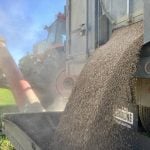This is the fifth in a series of articles about the future of agriculture. The series isn’t an attempt to forecast next month’s canola prices, but a look at what Canadian agriculture might look like in the long term, 20 years from now.
Simon Somogyi is the Arrell Chair in the Business of Food and also a professor at the University of Guelph’s School of Hospitality, Food and Tourism Management. With his focus on the agri-food value chain and management, he has studied food supplies in Canada and in other countries.
When asked about the transformations in store for the ag sector, Somogyi says, “Looking into the future I think the biggest innovation to disrupt farming is what I call precision fermentation and cultured meat.” Precision fermentation, Somogyi explains, is the “creation of dairy proteins not requiring a cow or cow mammary glands.”
Read Also

Are you ready for farm succession?
What motivates some farmers to make a succession plan while others don’t seem worried.
Milk producers will use bioreactors and engineered yeast to produce milk, which will then be used to make ice cream or any other type of dairy product. The resulting proteins, Somogyi says “are identical to the proteins that you would get from a cow.”
This seems like something from a sci-fi movie, but Somogyi says there’s a strong possibility that within five years cultured, precision fermented milk and other dairy products will be ready for sale to consumers. “This would be a significant disruptor,” he predicts.
Could there be an upside? In a future that uses fermentation to produce milk, cheese, butter, yogurt and other dairy foods identical to the ones we currently get from cows, Somogyi asks, could dairy producers take advantage of branding their products as “cow milk”?
Meat too
Milk isn’t alone, of course. Cultured, lab-grown meat is also in development. However, Somogyi says, “there will always be cattle-based meat.” He believes it will take more time to replicate the texture of steak or any meat with bones. The latest innovations in this space are coming in the area of seafood, such as sashimi and sushi-grade fish. “Effectively, it’s muscle and protein,” Somogyi says. “It doesn’t have bone.”
While plant-based meat products are currently more expensive than “the real thing,” Somogyi says “some suggest there might be price parity by 2027 with some products like ground beef.” Somogyi notes that consumers under 35 are the segment with the largest percentage of vegetarians. Animal welfare issues are the biggest driver of this consumption pattern. Plant-based substitutes for products like hamburger or chicken nuggets will be a good fit for these consumers.
Making the change
The dairy and beef sectors will be impacted differently by these changes. “If you look at beef,” Somogyi says, “I think it’s fairly clear that this won’t completely disrupt their sector, but will put pressure on it, particularly when they’re trying to sell lower-end cuts.”
For every steak, a certain amount of hamburger must also be sold in order for processors and farmers to profit. If demand for “real” hamburger and other low-end cuts declines when cheaper substitutes become available, Somogyi says, “they’re going to have to get higher returns for the prime cuts.”
Over the years, many players in the Canadian beef industry have focused on branding and quality, labelling beef by breed or by the location where it was raised, or both. This has helped to create a specialized product that consumers may continue to demand. The specificity of higher-end products might help protect the industry from market changes.
Canada’s dairy industry has focused on encouraging people to consume more milk, using a generic campaign, rather than branding milk production by the location where it’s produced, or even by the breeds producing the milk. Somogyi says, “this is going to play into the hands of processors who can easily get the microbes, water, sugars and electricity.”
It’s difficult to recreate the texture of prime rib, but it will be possible to make fermentation-based milk substitutes that have the exact same composition as milk produced in the “normal” way. When two jugs of milk are identical in taste and nutrition, consumers may well prefer the cheaper option, especially when it can be marketed to vegetarians as “animal-free.” The same logic applies to high-end ice cream, specialized yogurts and cheese.
How much market will meat and dairy substitutes ultimately replace? No one really knows. But what we do know is this, Somogyi says. Between now and when they arrive is an opportunity for the dairy and beef sectors to focus on strategy.
















